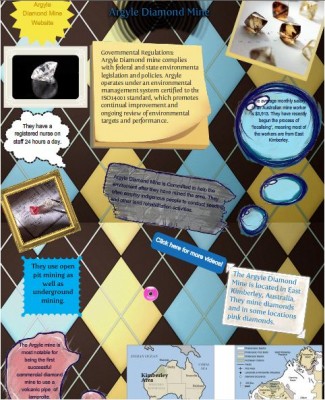Submitted by: Jane Selden and Katie Johnston
Collaborators: Annette Marchioli, Jon Morris, and Kim Morrison
School: J.R. Tucker High School
Summary
After completing water conductivity and world-wide water testing projects in class, we discussed careers in which these tests are used. I explained that my nephew, Justin Wisman, age 23, uses these tests in his job at a coal company in West Virginia. The students wanted to research a mine from their native country. In pairs, using Google and other search engines, students selected mines throughout the world. Once they decided on a mine, they researched the following information: history of the mine, type of material being mined, outline of the mining process, job descriptions and salaries of miners and scientists employed by the mine, governmental laws regulating the mine, and any other information as they found interesting or intriguing. Most of the students researched in their native language (Arabic, Vietnamese, Spanish, Portuguese, Japanese). They used Google Earth to visit their mine and saved the location as a Placemark. The students then contacted the mine companies through e-mail to ask specific questions about mining regulations and testing. Some also arranged tele-conferencing to speak directly to employees. The students summarized their findings in a presentation of their choice to the class, which included: the location of their mine, the materials mined, recommendations for improving mining conditions leading to better water quality, and other intriguing information as chosen by the student.
TIPC Ratings
APPROACHING – This lesson encouraged students to use a variety of digital tools to research their mine; Internet, Google Earth, Google Translator. When applicable, students used their native language skills to find and evaluate relevant information about their mines and applied what they had learned in class to make real world recommendations to improve mining effects on the environment.
IDEAL/TARGET – This lesson required the students to work together collaboratively in pairs within the classroom as well as globally with their respective mine personnel. Students communicated with mine employees through e-mails and tele-conferences. Students shared their final projects (Glogster, Power Point, etc.) by giving oral presentations in the classroom. Students will also be sharing their presentations with AP Environmental classes and other interested Earth Science classes through a Henrico Blog.
IDEAL/TARGET – After taking water samples from the community and testing water quality, students began to ask their own higher-level questions about the environment and mining, and ultimately led to the development of this class project. Building on students’ prior lab experiences, students investigated and learned about mines in other countries. They also found the location of their mine using Google Earth. Then they researched how mining effects the environment, gained a new understanding of mining regulations, and recommended ways to improve the overall effect of mining on the environment.
APPROACHING – Students created original works such as Power Point presentations or Glogster posters in order to display the information they learned during this project. Students collaboratively created the presentations addressing global mining issues and reached out to share what they learned with other students in our school community.
Download Files
Contents:
- Lesson Plan
- Student Artifact
- Click here for a link to the Rubric
- Click here for a link to a Student Artifact using Glogster





